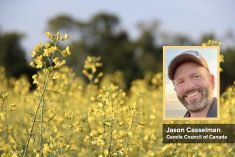Halfway through a study examining the role that harvest equipment plays in shatter losses when straight-cutting canola, Nathan Gregg is noticing some trends.
“We saw higher losses out at the edges of headers,” says Gregg, a project manager with the Prairie Agricultural Machinery Institute (PAMI) in Humboldt, Sask. “And losses dropped off as you moved toward the centre of the header, then they crept up again towards the middle.”
Maybe that’s not too surprising when you consider the “violence” experienced with most combine headers as they move crop material laterally to the centre where it all converges into the combine feeder house. But Gregg and his team wanted to know more — such as how far from the header ends were losses happening, does the type of divider make a difference, does the type of header itself make a difference, can some losses be recovered?
Read Also

Could crop sharing be a viable option for your farm?
Crop sharing could be a good option for young and beginning farmers.
The three-year research project led by PAMI was launched in 2014 and is a collaborative effort by many parties with an interest in finding answers to some of these questions, including Western Grains Research Foundation (WGRF), which is helping to fund the study. And as the popularity of straight-cutting canola continues to rise with farmers who want to save time, increase yields and protect crop quality, helping them understand how their equipment can work for (or against) those goals is becoming more important.
“We want to provide information so famers can make some decisions about their equipment,” says Gregg. Are there any adjustments, add-ons or modifications they can make to their existing header that will reduce shatter losses? The idea, he says, is to allow farmers to make the most of straight cutting without necessarily having to buy a whole new header.
Trends worth watching
Since minimal public research on this had yet been done, very little was known about the precise impact of header equipment on pod shattering and the first year of the study, 2014, was designed to establish some benchmarks.
Four different equipment configurations (known as treatments) were used on two different canola varieties — a shatter-resistant hybrid and a regular hybrid — on two field sites (Indian Head and Swift Current). The check treatment was swathing, and the straight-cutting treatments were a draper header, a rigid auger header and a European header with an extendable cutter bar.
Researchers worked on a field scale using 35- and 36-foot headers, so this is definitely not small-plot work. And to make sure that apples were being compared to apples, all treatments were identical — everything stayed the same during harvest, from driving speed to reel, knife and threshing speeds. Shatter-loss collection pans were distributed throughout the fields along the width of the headers and the contents cleaned and weighed to find out where losses were occurring and to what degree.
Gregg reminds growers the study is not just about yield differences, but also header loss differences.
“After two years, we are still seeing that there’s no runaway winner among the headers as far a yield goes,” he says, although he will say that, for the straight-cutting treatments, shatter-resistant hybrids consistently outperform the regular hybrids.
“We have data to show shatter-resistant technology works. But we are starting to see a few trends with header losses, too.”
Across all headers
For example, in 2014, the collection pans revealed a loss pattern across all headers.
This is the pattern already mentioned, starting at the outer portions of the headers with relatively high losses that moderate as you move inward, and then pick up again near the header’s middle.
To get more specific information about those losses and what was causing them, the team did some more intensive sampling with the collection pans in 2015.
“We collected in fewer field locations but with a higher intensity of pans across the header,” says Gregg. “What we found bore out the trend of losses happening at the edges, but we now see those losses are extending a few feet from the end rather than just right at it. So we looked closer at the divider. We used an active divider on all treatments, and we wondered if that was contributing to loss rather than preventing it.”
To test that theory, the team needed to compare powered-knife dividers to static ones, and they couldn’t do that within the experiment’s current configuration because everything had to remain equal for the results to be meaningful. Luckily, another seed company came on board in 2015, and Gregg’s team was able to set up a third site to do the kind of testing needed to answer questions like this.
“We found the fixed divider showed potentially lower losses,” says Gregg. “But that was only on one side of the header. On the other side, where the knife drive is, there was higher loss.”
He points out that losses were lower on the sleek, smooth side with the narrow divider. “What it says is that it may be worth your time and money to smooth the blunt and rougher edges of dividers”
And the powered dividers? “We found a rotary divider results in high shatter losses and, not only that, but the losses were spread out over a wider area, whereas a vertical knife showed less loss, and not spread as far,” he says.
He notes that powered dividers, especially the rotary ones, are common on windrowers on the Prairies because they allow better forward progress in green, tough, interconnected crop conditions. “But in dry crop conditions, like standing matured canola, is this divider creating loss rather than preventing it?”
Gregg says that thus far the active dividers have not been necessary to effectively divide the crop canopy during straight-cut harvest operations, unlike when dividing greener plant material while windrowing.
Back in the two main field sites, researchers wondered why shatter loss increased at the centre of the header. “And does that loss go out the front of the header or is it the stuff landing on the feeder house?” Gregg asks. The team found that a good portion of the losses from the centre are, in fact, spit forward and that one header type, the European style, seems to be better equipped to deal with that.
“When the extendable knife is extended all the way forward, it’s retaining those potential losses.”
There is still a long way to go and many variables to experiment with as the third and final year of the study approaches.
“We’ve used fixed combine settings and speeds across all the treatments so far,” says Gregg. “We want to push the envelope a bit and see if there are differences with speeds. Anecdotally, people say they can go faster when straight cutting, while others say they need to go slower. We do think the extendable cutter bar can minimize losses compared to the other treatments, but will this hold at faster speeds?” He certainly aims to find out.
The team is also considering looking into whether or not desiccation, or a similar harvest aid, contributes to shatter losses, and if the trade-off for evening out or accelerating crop maturity is acturally worthwhile.
They’re also listening to farmers’ experiences and thinking about that as they refine the project’s design. For example, Gregg has heard some growers insist they can’t make any progress straight cutting without a cross auger on a draper header.
“But we’ve never had ours be a critical factor in the four site-years of the study,” he says. “Maybe it goes back to speed and feed rate.”
As yet another question is added to the mix, Gregg is confident that by the end of the study, his team will have some useful information for farmers wanting to straight cut canola more effectively. “Our goal is that farmers can look at our results and decide if they can try this with the equipment they’ve got or if the economics make sense for them to use a different header type.”
WGRF is a farmer-funded and directed non-profit organization investing in agricultural research that benefits producers in Western Canada. For over 30 years the WGRF board has given producers a voice in agricultural research funding decisions. WGRF manages an Endowment Fund and the wheat and barley variety development checkoff funds, investing over $14 million annually into variety development and field crop research. WGRF brings the research spending power of all farmers in Western Canada together, maximizing the returns they see from crop research.















